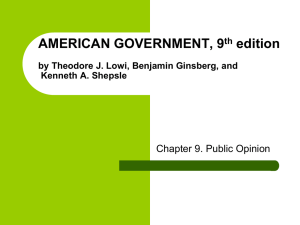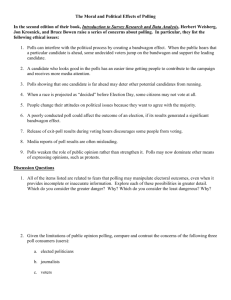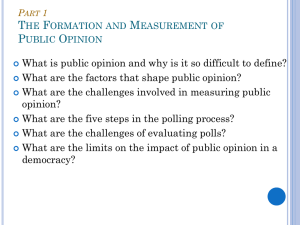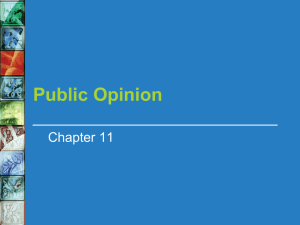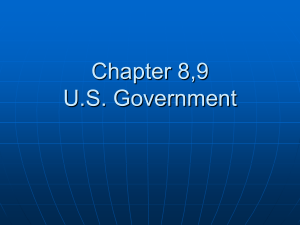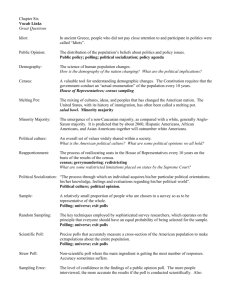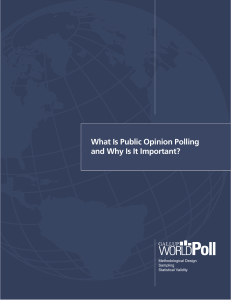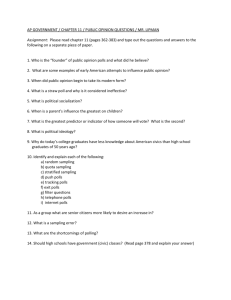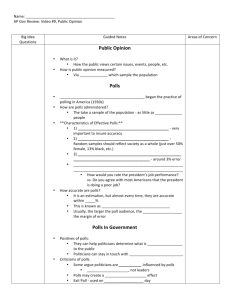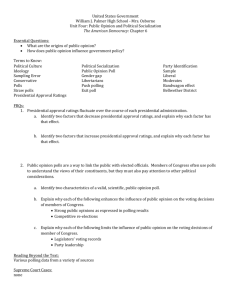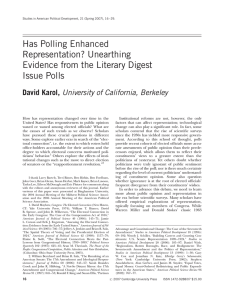AMERICAN GOVERNMENT POWER AND PURPOSE, 8th Edition
advertisement
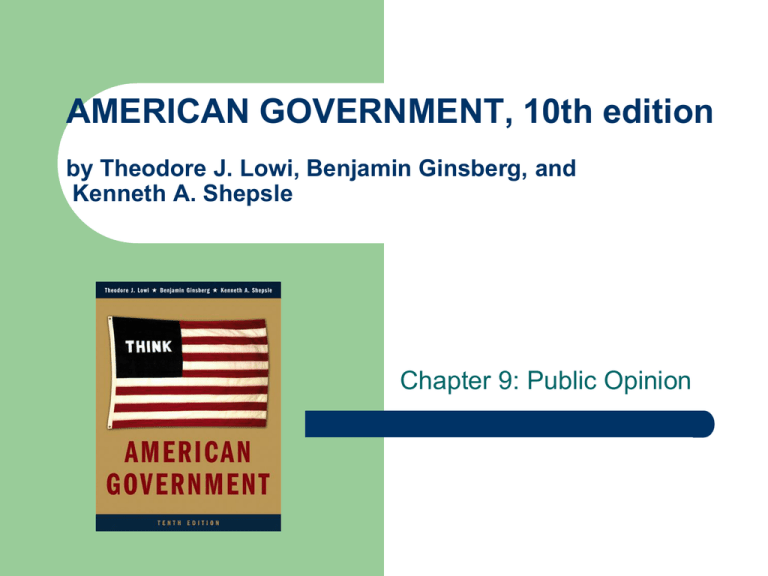
AMERICAN GOVERNMENT, 10th edition by Theodore J. Lowi, Benjamin Ginsberg, and Kenneth A. Shepsle Chapter 9: Public Opinion Debate Redux http://www.youtube.com/watch?v=l63SRpGXBHE&feature=related America’s Tyrannical Majority Observing America in the 1830s, Alexis de Tocqueville warned of the potential for the “tyranny of the majority.” “I know of no country in which there is so little independence of mind and real freedom of discussion as in America … In America the majority raises formidable barriers around the liberty of opinion; within these barriers an author may write what he pleases, but woe to him if he goes beyond them.” —Alexis de Tocqueville, Democracy in America Characteristics of Public Opinion Definition Public opinion is the values and attitudes that people have about issues, events, and personalities. Characteristics Direction Intensity Saliency Latency Public opinion has direction. Whatever the response to a public opinion poll (yes or no; more or less; 1 or 100) people have opinions about proper directions and preferred alternatives. Liberals are said to be on the “left,” and conservatives are said to be on the “right.” If “direction” measures what people think, intensity refers to how deeply individuals hold a given opinion and how likely they are to act on it. Not all opinions are equally felt by citizens, so not all opinions are equally consequential for politics. If direction and intensity characterize individual opinions, saliency and latency are characteristics of overall opinion. Salient opinion is that which enjoys widespread public attention and is a high priority. Latent opinion may be widespread but generally remains in the background unmolded, unmobilized, and uncrystallized. As Tocqueville might have predicted, one negative consequence of the “marketplace of ideas” is that unpopular ideas might not be given a chance to compete, regardless of their potential merit. Should they seem at first glance to be unpopular, such potentially good ideas are likely to go unexpressed. Thus, they do not receive the consideration that might make them seem more appealing. For this reason, differences in public opinion can be very valuable. Differences in Public Opinion Despite widespread agreement, fundamental disagreements continue, over not only specific issues but also how we define our core areas of consensus. Political divisions between “liberals” and conservatives” reflect relatively consistent differences among Americans. Moreover, demographic differences (between and among racial and ethnic groups and between men and women) persist and define many of the important political battles in American politics. Beyond demographics, public opinion is also affected by other agents of socialization like education levels and membership in social groups. Differences between religious groups are one example. Agents of socialization are the social institutions, including families and schools, that help shape individuals’ basic political beliefs and values. Shaping Opinion Political opinions are also shaped in the “marketplace of ideas” by: – – – political leaders private groups the media Governments and politicians seek to monitor and shape public opinion to build public support for governmental actions and policies. In recent years, politicians have increasingly used technologies such as public opinion polls and media appeals, to shape public opinion. Other political actors, such as outside interest groups and the mass media, seek to sell their ideas and influence “tastes” in the idea marketplace. Measuring Public Opinion Public opinion polls, scientific instruments for measuring public opinion, are now prevalent in American politics. Media organizations – newspapers and television – often have in-house polling operations and report public opinion data on a regular basis. How are Polls Conducted? http://www.thedailyshow.com/video/index.jhtml?videoId=156231&titl e=team-daily-polls Pollsters begin by choosing a small group of respondents to represent the most important characteristics of an entire population. Selecting a representative sample is key to being able to make generalizations about a poll’s results. If done correctly, public opinion polls are remarkably accurate snapshots of public sentiment at any given time and reasonably good predictors of election outcomes. Poor construction and mistaken interpretations of polls can misrepresent public opinion: – – – – poor sampling question wording and ordering illusion of saliency illusion of central tendency The Literary Digest Fiasco 1936 The Literary Digest had predicted the winner in every presidential election since 1916, and had based its 1936 predictions on the largest response to any poll in history -- over 10 million questionnaires were mailed using lists of automobile and telephone owners -- over 2.3 million people responded. FDR was just completing his first term – and was facing a tough challenge from Republican Alf Landon. The Literary Digest predicted that Landon would beat FDR -- 57 to 43 percent. At the same time, a young George Gallup sampled only 50,000 people and predicted that Roosevelt would win. Gallup's prediction was ridiculed as naive. But Roosevelt won with 62% of the vote. The size of the Digest's error is staggering. How could they have been so far off? The Literary Digest had made two fatal mistakes: Sampling Bias -- Their list of names came from lists of cars and phone owners – an inherently affluent sample (a much smaller portion of the population in the thirties than it is today). Self-Selection Bias -- The Digest had depended on voluntary response. FDR was the incumbent, and those who were unhappy with his administration were more likely to respond to the Digest survey. Polls and their results can also influence public opinion. Poll results can produce the bandwagon effect whereby there is a shift in support to a candidate or opinion because the polls portray its popularity. Push polling is a technique in which the questions asked in a poll are designed not to measure a respondent’s opinion but to change it. More than simply representing (or misrepresenting) public opinion, polling actually transforms opinion and has an effect on its importance in politics. Prior to widespread poll use, politicians used informal methods to measure public sentiment. They would monitor press reports and editorials; tabulate letters and phone calls from constituents; consult “opinion surrogates” like barbers and cab drivers. When polling replaced these more informal methods of measuring public opinion, the new technology actually transformed the opinion that influenced politics. When polls are conducted correctly they are remarkably accurate. For this reason, politicians and political observers pay a great deal of attention to polling. Public Opinion and Democracy What is the proper use of polls in American politics? To retain its democratic characteristics, American politics must reflect public opinion in important respects. But to remain republican, American politics must avoid constant decision making by plebiscite. Although most politicians deny being “poll-driven,” most politicians at the national level (and all modern presidents) use polls to make decisions. There are several problems associated with making policy based on polls. The American public frequently lacks adequate information on policies. Public opinion often lacks coherence and is internally contradictory. Public support is volatile and changes over time. Public Approval/Disapproval of President Bush's Handling of Iraq 80 70 60 40 30 20 10 8/27/2007 6/27/2007 4/27/2007 2/27/2007 12/27/2006 10/27/2006 8/27/2006 6/27/2006 4/27/2006 2/27/2006 12/27/2005 10/27/2005 8/27/2005 6/27/2005 4/27/2005 2/27/2005 12/27/2004 10/27/2004 8/27/2004 6/27/2004 4/27/2004 2/27/2004 12/27/2003 10/27/2003 8/27/2003 6/27/2003 0 4/27/2003 Percent 50 Date Approve Disapprove Source: ABC News/Washington Post Poll, various dates, 2003-2007. (http://www.pollingreport.com/iraq.htm) The question asked of respondents was “Do you approve or disapprove of the way Bush is handling the situation in Iraq?” To what extent should public support for the war in Iraq influence U.S. foreign policy? What are the drawbacks of conducting a war based on polls? What are the implications for a democracy in which public opinion is not effective in determining foreign policy?
